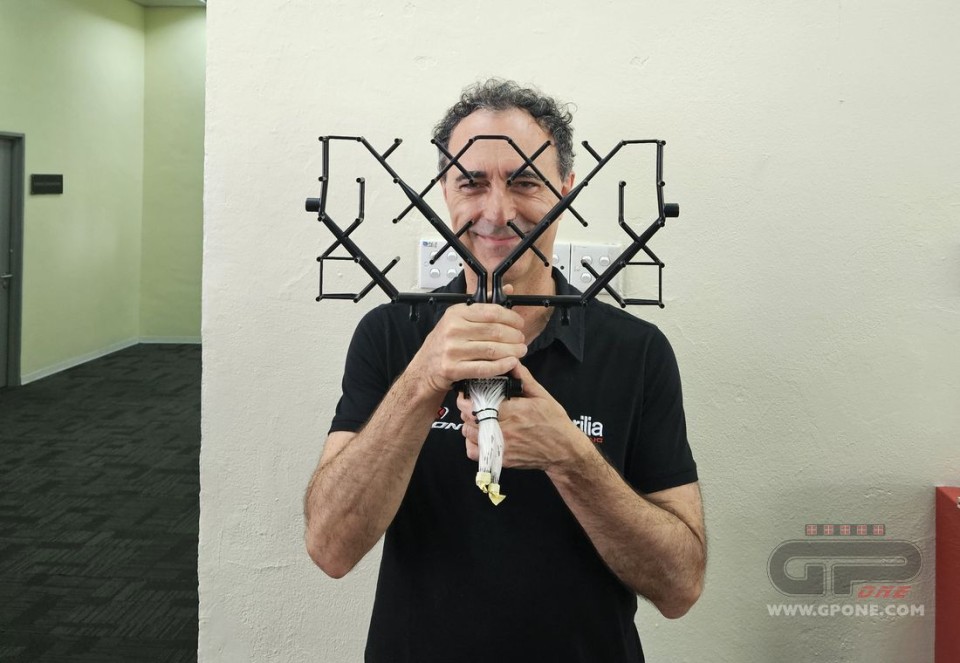Romano Albesiano doesn't lack a sense of humour and at Sepang he poses by playing with the aero rake, the sensors measuring the aerodynamic flow mounted yesterday on the Aprilias. After all, nothing less could be expected from an aeronautical engineer and the men from Noale, under his guidance, have indulged themselves in recent years, introducing many solutions later copied by their adversaries.
This flourishing of wings and assorted appendages also makes many fans and former riders turn up their noses, worried about approaching the excesses of Formula 1. Do we need a limit? “There are already many limits, a series of very detailed rules – was the response from Aprilia's technical director - even if one is missing on the surfaces that can be used, but aerodynamics are not just used to crush the bike to the ground. We need to understand what happens when the bike is at various lean angles, it's a very complex field. Plus, it costs a lot less than developing an engine, that's the most expensive thing of all. If you compare the costs and how much people talk about it, it is extremely advantageous, there is great interest in this field."
Aerodynamics seems to be the simplest solution of MotoGP, the field where the battle between manufacturers is most intense. Even though all that glitters is not gold. For example, more downforce means less top speed in a straight line.
“It depends on the configuration, but we can talk about an order of 4 or 5 km/h - explains Albesiano - However, at the end of the day, it is still worthwhile, even if we must take into account one aspect which in the automotive world is very limited, if not non-existent: on motorbikes the sensations of the rider are dominant. You can do all the calculations in the world, but if the rider doesn't like it, even with a configuration with very high potential you can go very slowly."
This is why testing is essential. “We simulate aerodynamics on the computer, having a prediction of the air flows, it is a virtual wind tunnel. Then you have to confirm these simulations, in the wind tunnel and in the tests": it is in these days in Sepang that the issues come to a head.
It’s not an easy job, because there are many variables, like the configurations.
“The possible combinations of aerodynamic parts and other things, like swingarms, are increasing every year and it's becoming something of a puzzle. At the moment we have more than 20 possible ones, it is clear how difficult it is to manage all the work during the test days" revealed the engineer.
Not to mention that there are also many other areas to work on. For example, Aprilia has a tendency to 'cook' its riders by releasing excessive heat.
“We haven't solved that problem yet - admits Albesiano - Today we did a sort of race simulation with our 3 riders to work in that area and we want to solve it for the Asian races at the end of the year, otherwise we will be in trouble again”.
Furthermore, they need to understand why the RS-GP struggles more on some tracks than on others.
“We haven't fully understood it yet, I would say it is related to the functioning of some components at high temperatures. Let's say that those problems were due 50% to tyre management and 50% to other parts" was Albesiano's response.
Logically, the engineer does not want to reveal his secrets and it is futile to ask him for detailed explanations on the shapes of the Aprilia. However, one thing stands out: after 'inventing' the wing on the tail, the RS-GP no longer used it, while KTM, Yamaha and Honda introduced it.
“We tried it for the first time at Mugello with the team test - he recalls - but, for some reason, it's not easy to make it work on our bike. We have some ideas as to why, but not entirely clear. It's as if the bike doesn't accept it, it's not enough to fit it for everything to go better, you need to work on the balance. I think it's related to weight distribution. We expect it to increase rear ground contact when braking, which is why we did it. However, during acceleration the opposite effect is obtained, the lift increases, so it must be compensated and balanced with the front wings. Furthermore, it has an effect when the rear tyre, after having risen, returns to touch the asphalt and it is a very delicate phase".
The last curiosity is whether we have reached the point that a MotoGP is designed with aerodynamics in mind.
“We're not at that point yet, there isn't that type of conditioning. It also depends on the regulations, probably in the future they will limit our space for action, so I don't think we will reach that point” he concludes.









